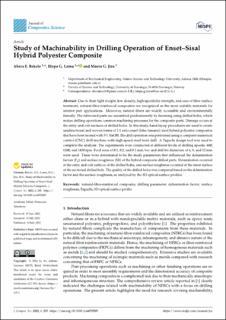| dc.contributor.author | Bekele, Abera E. | |
| dc.contributor.author | Lemu, Hirpa Gelgele | |
| dc.contributor.author | Jiru, Moera G. | |
| dc.date.accessioned | 2022-08-18T08:48:00Z | |
| dc.date.available | 2022-08-18T08:48:00Z | |
| dc.date.created | 2022-08-17T13:41:10Z | |
| dc.date.issued | 2022-07-14 | |
| dc.identifier.citation | Bekele, A. E., Lemu, H. G., & Jiru, M. G. (2022). Study of Machinability in Drilling Operation of Enset–Sisal Hybrid Polyester Composite. Journal of Composites Science, 6(7), 205. | en_US |
| dc.identifier.issn | 2504-477X | |
| dc.identifier.uri | https://hdl.handle.net/11250/3012510 | |
| dc.description.abstract | Due to their light weight, low density, high-specificity strength, and ease of fiber surface treatment, natural-fiber-reinforced composites are recognized as the most suitable materials for interior part applications. Moreover, natural fibers are widely accessible and environmentally friendly. The fabricated parts are assembled predominantly by fastening using drilled holes, which makes drilling operations common machining processes for the composite parts. Damage occurs at the entry and exit surfaces of drilled holes. In this study, hand layup procedures are used to create unidirectional and woven forms of 1:1 ratio enset (false banana)/sisal hybrid polyester composites that have been treated with 5% NaOH. The drill operation was performed using a computer numerical control (CNC) drill machine with high-speed steel twist drill. A Taguchi design tool was used to complete the analysis. The experiments were conducted at different levels of drilling speeds: 600, 1200, and 1800 rpm. Feed rates of 0.1, 0.2, and 0.3 mm/rev and drill bit diameters of 6, 9, and 12 mm were used. These were determined to be the study parameters that influenced the delamination factors (Fd) and surface roughness (SR) of the hybrid composite drilled parts. Delamination occurred at the entry and exit surfaces of the drilled holes, and surface roughness occurred at the inner surface of the sectioned drilled hole. The quality of the drilled holes was compared based on the delamination factor and the surface roughness, as analyzed by the 3D optical surface profiles. | en_US |
| dc.language.iso | eng | en_US |
| dc.publisher | MDPI | en_US |
| dc.rights | Navngivelse 4.0 Internasjonal | * |
| dc.rights.uri | http://creativecommons.org/licenses/by/4.0/deed.no | * |
| dc.subject | natural-fiber-reinforced composite | en_US |
| dc.subject | drilling parameter | en_US |
| dc.subject | delamination factor | en_US |
| dc.subject | surface roughness | en_US |
| dc.subject | Taguchi | en_US |
| dc.subject | 3D optical surface profile | en_US |
| dc.title | Study of Machinability in Drilling Operation of Enset–Sisal Hybrid Polyester Composite | en_US |
| dc.type | Journal article | en_US |
| dc.type | Peer reviewed | en_US |
| dc.description.version | publishedVersion | en_US |
| dc.rights.holder | Copyright: © 2022 by the authors | en_US |
| dc.subject.nsi | VDP::Technology: 500 | en_US |
| dc.subject.nsi | VDP::Technology: 500::Materials science and engineering: 520 | en_US |
| dc.subject.nsi | VDP::Technology: 500::Mechanical engineering: 570 | en_US |
| dc.source.pagenumber | 1-14 | en_US |
| dc.source.volume | 6 | en_US |
| dc.source.journal | Journal of Composites Science | en_US |
| dc.source.issue | 7 | en_US |
| dc.identifier.doi | https://doi.org/10.3390/jcs6070205 | |
| dc.identifier.cristin | 2043841 | |
| dc.source.articlenumber | 205 | en_US |
| cristin.ispublished | true | |
| cristin.fulltext | original | |
| cristin.qualitycode | 1 | |

